I Tested 5 Cordless Jigsaws: These Are the Best (2024)
There’s no shortage of options when it comes to picking a new jigsaw for your shop. That’s why I tested some of the most popular cordless jigsaws to help you find the best one for your needs. Here’s my list of the best cordless jigsaws.
In a hurry? The DeWalt Top Handle Cordless Jigsaw is the best cordless jigsaw all around, thanks to it’s power, efficiency, durability, versatility, and price when compared to other name brand cordless jigsaws. It also has a great battery life, which allows you to get more done with a single charge.
Best Cordless Jigsaws
- #1 Best Overall – DeWalt Top Handle Cordless Jigsaw
- Highest Quality – Milwaukee Cordless Jigsaw
- Best Value – Black and Decker Cordless Jigsaw
- Best for Woodworking – Ryobi ONE+ Cordless Jigsaw
- Most Versatile – Craftsman Cordless Jig Saw
1. DeWalt Top Handle Cordless Jigsaw – #1 Best Overall
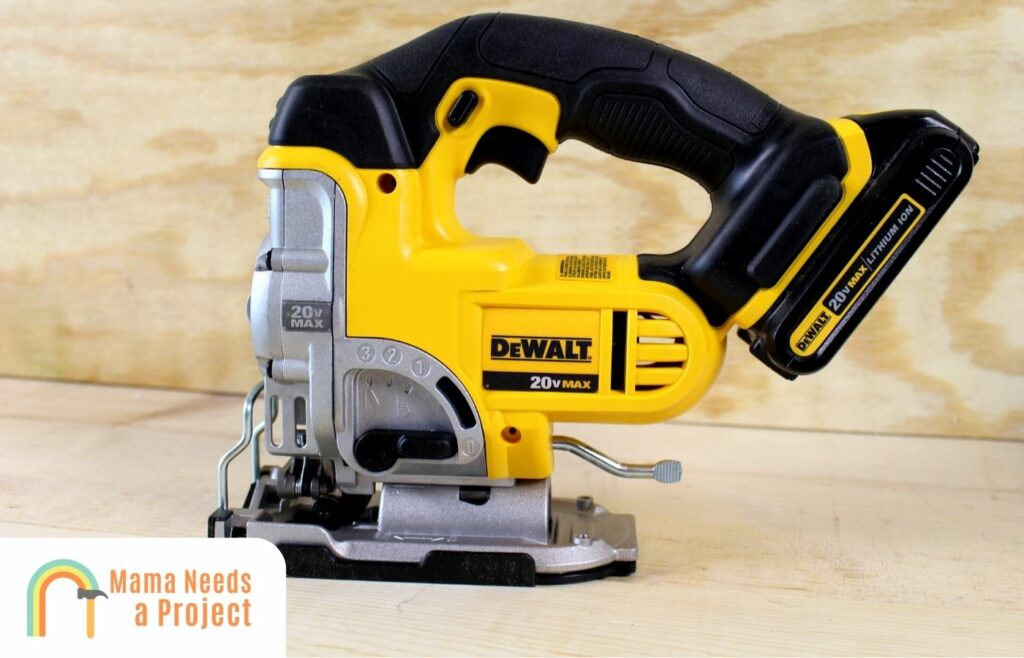
The DeWalt Top Handle Cordless Jigsaw is superior to all other cordless jigsaws on this list because it’s powerful, efficient, durable, versatile, and easy to use whether you’re a professional or DIYer. It’s also cheaper than other battery-powered jigsaws of similar quality, so what’s not to love?
It runs on a DeWalt 20V Max battery and its brushless motor is capable of generating 3,000 strokes in a minute.
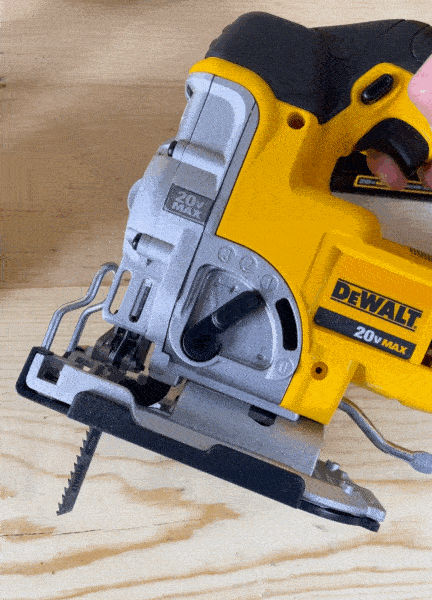
This saw takes T-shaped blades, and there’s no wrench or hex key required to fasten or remove blades.
The “shoe” or “foot” is the rectangular base around the blade, and this can be tilted at several angles so the jigsaw can make bevel cuts. You’ll need a hex key to adjust the foot, which you’ll get when you purchase this saw.
There are also four orbital cutting positions, and the speed of cutting is controlled by a variable-speed trigger.
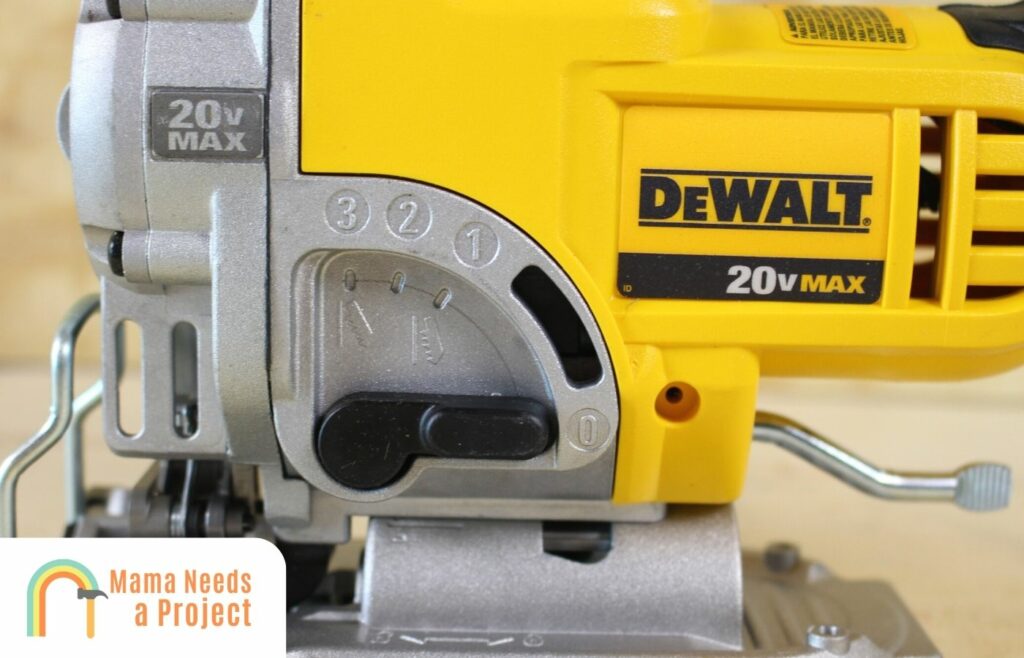
A dust blower is employed as well so dust can be blown from the cut line as the jigsaw cuts.
Also, this jigsaw has an anti-slip grip and ergonomic handle to ensure comfortable and easier operation that I really like.
Finally, it’s 11.25” x 11” x 3.9” and nearly six pounds without the necessary battery equipped.
What I Liked:
- Powerful, long-lasting battery ensures long runtime
- Easy to maneuver since it’s compact, well-designed, light & cordless
- Several speed settings ensure it can make smooth cuts in numerous materials
- Durable, sturdy foot ensures stability when cutting
- Dust blower makes achieving precise cuts much easier
What I Didn’t Like:
- Can only accommodate more expensive T-shank blades, but this is expected
- Too powerful for especially thin wood-based materials
My Thoughts
Unquestionably, the DeWalt Top Handle Cordless Jigsaw is the best cordless jigsaw on my list, since it’s such a powerful, durable, and efficient saw. Its got that toughness DeWalt is known for, yet it can be nimble when making curved and bevel cuts. And at this price, it’s hard to find a name brand jigsaw with more capabilities. Additionally, if you have other DeWalt tools, you can swap the batteries – saving you time and money. My only complaints with this battery powered jigsaw is that is is slightly more expensive and that it doesn’t accommodate U-shank blades, but other than that – this is an amazing jigsaw I would highly recommend. It’s also one of the best jigsaws for beginners and you can read my full DeWalt jigsaw review for more info!
Other Stores
2. Milwaukee Cordless Jigsaw – Highest Quality
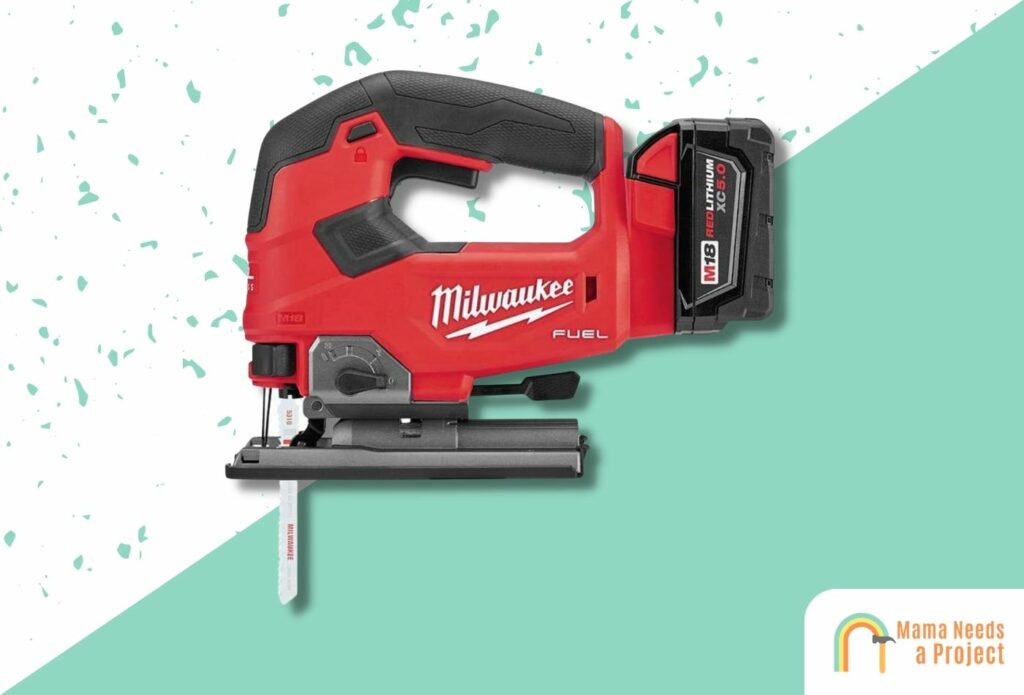
When it comes to cutting quality, the Milwaukee Cordless Jigsaw is going to get you the best results, as it uses numerous high-end components to ensure precise cutting through a range of materials.
For one, its brushless motor is more powerful than the motors other jigsaws use, and it can deliver up to 3,500 blade strokes in a minute.
This means that this saw can cut through just about anything including both hard and soft woods, plastics, and more.
And because it runs on a powerful M18 battery, it can cut up to 105’ in laminated particle board before a recharge is necessary.
Like other jigsaws, it has four orbital cutting positions, and its shoe can be adjusted to make 0°, 15°, 30°, and 45° bevel cuts.
There’s a dust blower and an LED light to assist with cutting, and it comes with an anti-scuff shoe that comes in handy when cutting finished surfaces.
And this jigsaw doesn’t just blow dust off the cut line—it can extract dust too so it never affects the inner components.
This jigsaw also employs Redlink Plus Intelligence overload protection, which can help protect the tool so it lasts longer.
Lastly, it’s 20” x 5.31” x 14” and nearly 13 pounds (when the battery is attached).
What I Liked:
- Powerful brushless motor ensures fast cutting through just about any material
- Superior dust-management components and overload protection ensure longevity
- Easier to make straight crosscuts & angled cuts because it’s heavier
What I Didn’t Like:
- Its weight can make intricate cuts harder to achieve
- Comes with a higher price-tag than other cordless jig saws
My Thoughts
No other jigsaw does quality cutting like the Milwaukee Cordless Jigsaw. It features the best and most durable components to ensure precise cutting each time it’s used, and it’s powerful enough to cut through the densest woods and even thick nonferrous metals. Its durability ensures stability when cutting, and its dust-management components not only protect it but also make precise cuts easier to achieve. If it wasn’t so heavy and wasn’t a little less expensive, this saw would be at the top of my list. This is a top quality jig saw that you can’t go wrong with.
Other Stores
3. Black and Decker Cordless Jigsaw – Best Value
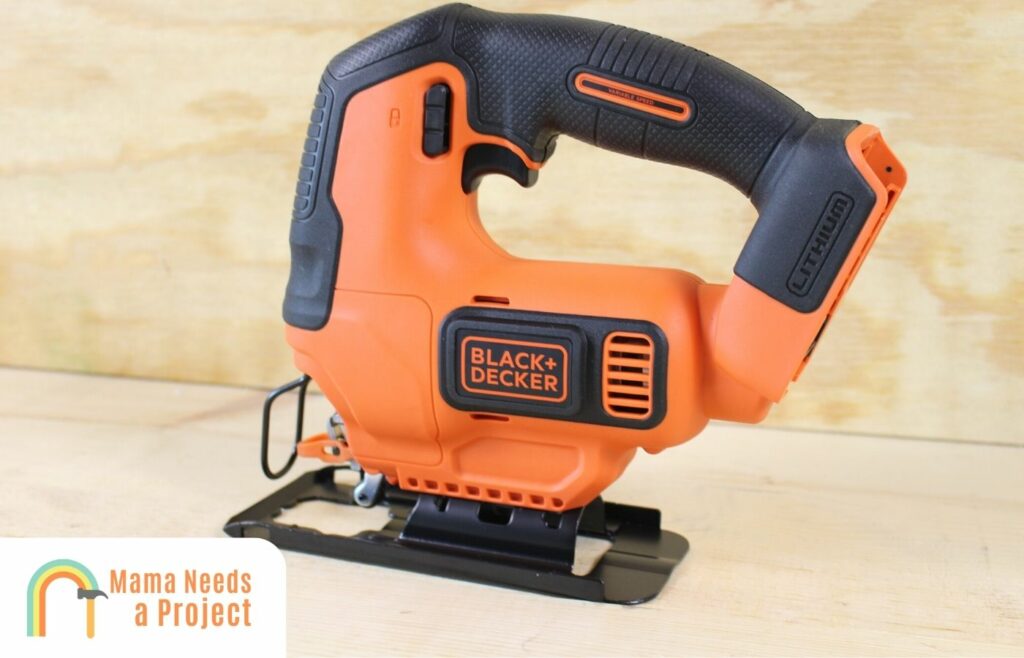
The best value pick is the Black and Decker Cordless Jigsaw since it’s much less than high-end jigsaws yet still efficient, versatile, and capable in numerous ways. This is easily one of the best budget jigsaws you can buy.
Like other cordless jigsaws, it utilizes a brushless motor, one that’s capable of generating 2,500 rpm.
How fast the blade moves is determined by the jigsaw’s variable speed trigger, meaning you set the speed you want (using the nearby switch) and then press the trigger to power the saw.
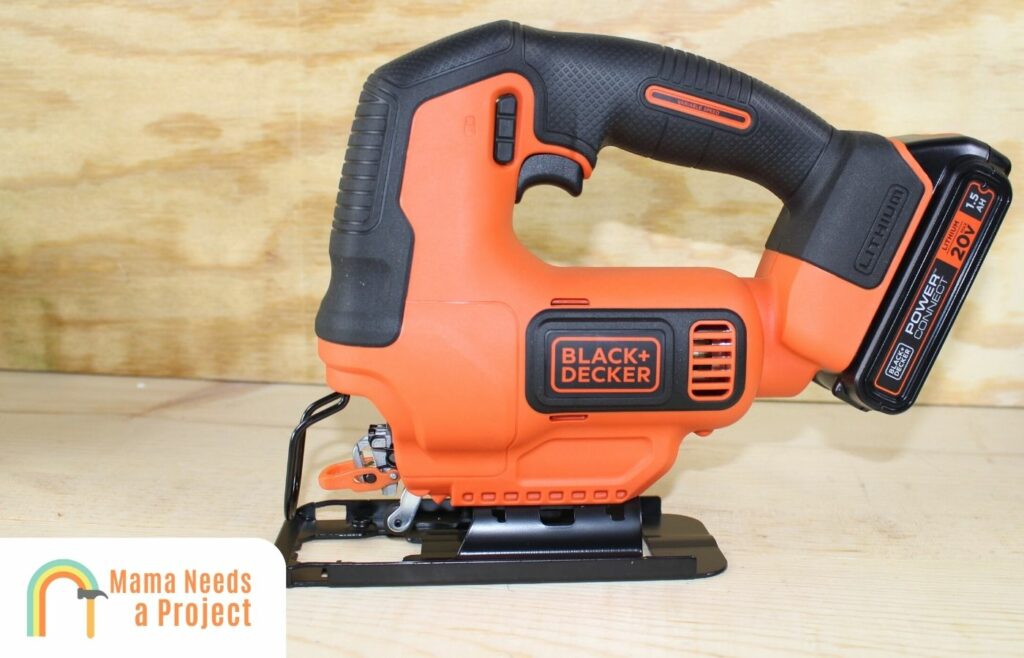
Its foot is pretty sturdy and it can be slanted to the left or right to make different bevel cuts; a hex key is required to adjust the foot.
It accepts both T-shank and U-shank blades, and no wrench or key is needed to remove or fasten the blades.
While it doesn’t have an LED light, it does have a wire guard to help with precision cutting.
A dust blower is used as well to ensure visibility when cutting and it also protects the more sensitive components from damaging sawdust and other fine particles.
What I Liked:
- Price & quality make it a cost-effective purchase for DIYers & hobbyists
- Easy to maneuver thanks to compact design & minimal weight
- Takes both U- and T-shank blades which can be handy if you prefer U-shank blades
- Pretty accurate thanks to the wire guard
What I Didn’t Like:
- Foot could be thicker & a little heavier for better stability
- Has a tougher time cutting through denser materials because of the less powerful motor
My Thoughts
If you want a quality cordless jigsaw but you don’t want to spend an arm and a leg, the Black and Decker Cordless Jigsaw is perfect for you. It features many of the components that make high-end jigsaws sought-after, yet it’s sold at a much cheaper price. Granted, it’s not as powerful as the two jigsaws ranked above it, but that may not be a problem for you if you never cut denser materials and just want something that will get the job done. Also, a sturdier foot would be nice, but these are just minor gripes. Overall, it’s great jigsaw for the price.
Other Stores
4. Ryobi ONE+ Cordless Jigsaw – Best for Woodworking
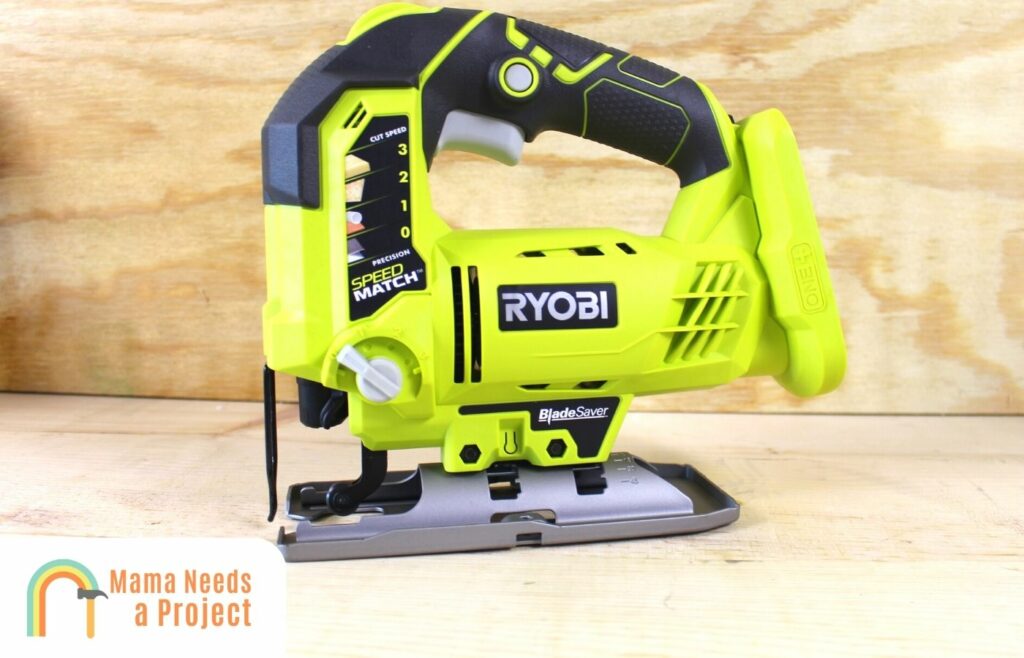
The Ryobi ONE+ Cordless Jigsaw is a powerful, easy-to-use, and compact cordless jigsaw with many components that allow you to get the absolute most out of this tool.
For example, this cordless jigsaw features a blade-saving feature, which essentially allows the user to drop the foot whenever the main part of a blade has worn down—this way the less-worn section can be utilized.
There’s also a trigger-locking system which allows for sustained cutting over an extended period and it has a 4 setting variable speed control.
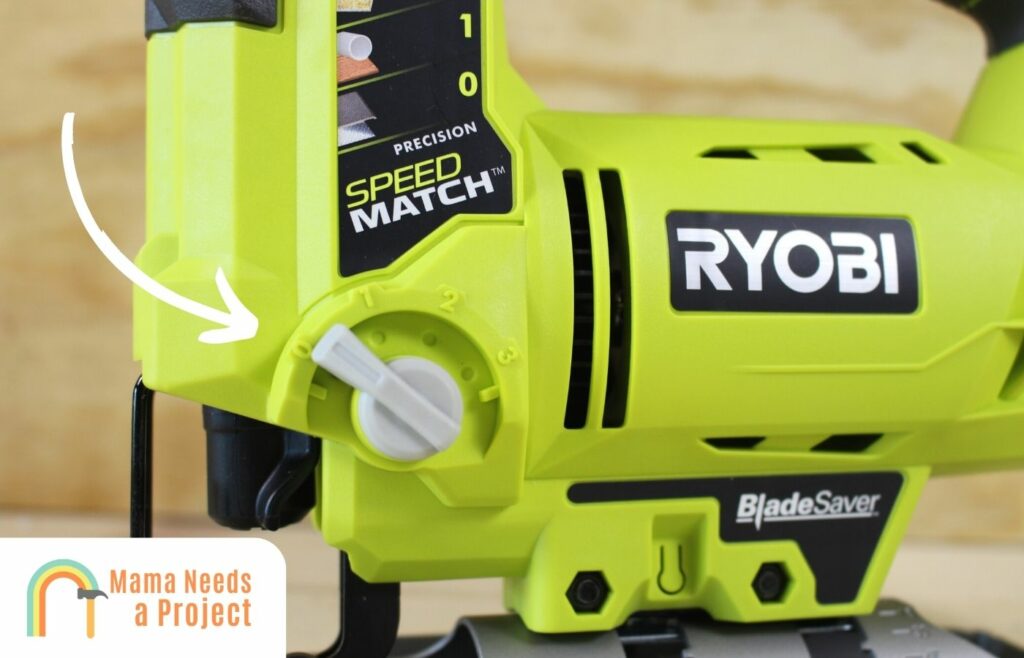
And like the other cordless jigsaws on this list, this tool is powered by a brushless motor that can generate 3,000 strokes in a minute.
Running on an 18V battery, in can deliver up to 100’ of cutting before it’ll need a recharge.
It takes T-shank blades and has four orbital settings, and you don’t need a wrench or hex key to fasten or remove the blades.
There’s a built-in dust blower so you can clearly see what you’re cutting, and it has an LED light to allow for work in dimly-lit environments.
As far as dimensions go, this tool is 9.84” x 8.74″ x 3.39”, and it’s on the lighter side (weighing just over five pounds without the battery attached).
What I Liked:
- Blade-saving feature ensures you don’t have to keep buying blades which I love
- Well-designed handle and barrel grip make this a comfortable jigsaw
- A handful of guidance components are used to ensure precision cutting
- Price is relatively low when you consider all its capabilities
What I Didn’t Like:
- The variable speed dial it utilizes can be difficult to set
- Reliance on T-shank blades means it’s somewhat less versatile, but not a huge deal
My Thoughts
The Ryobi ONE+ Cordless Jigsaw is another one of the best cordless jigsaws because it’s great in several key respects, but it’s not as versatile nor as powerful as the DeWalt or Milwaukee jigsaws. That said, this tool is held in high esteem by both contractors and DIYers, which speaks to its dependability and ease of use. My only real complaints are the power it produces and the variable speed control dial. If it was slightly more powerful and had a trigger instead of dial to adjust the speed, I’d be all over this saw. You can also ready my Ryobi Jigsaw review for more info!
Other Stores
5. Craftsman Cordless Jig Saw – Most Versatile
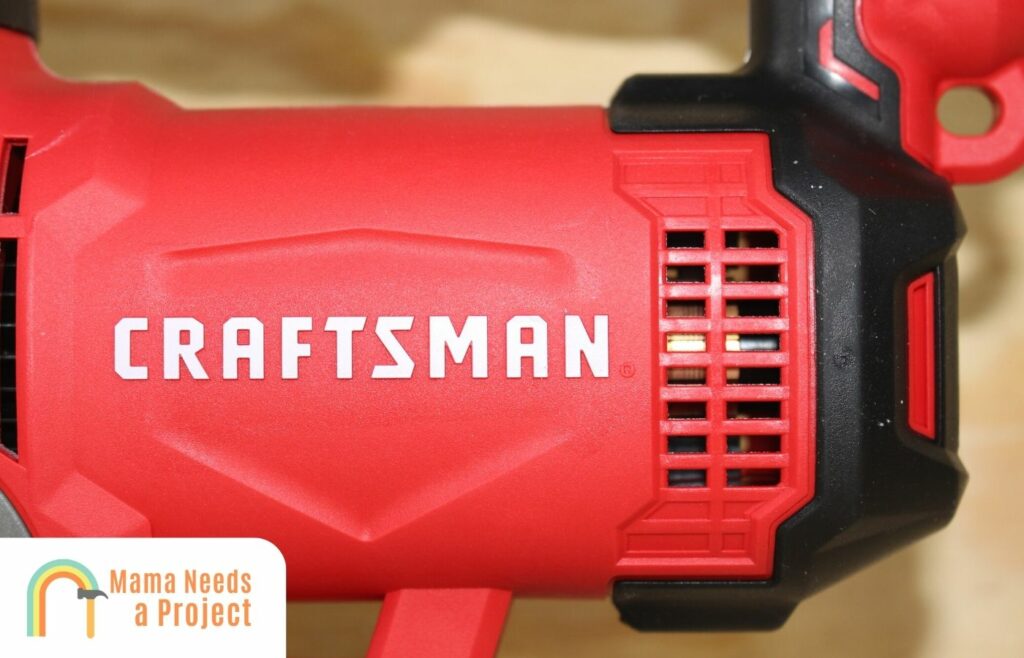
Known for its versatility, the Craftsman Cordless Jig Saw is a well-built, efficient, and easy-to-use lithium ion cordless jig that’s capable of delivering a range of cuts across different materials.
It runs on a powerful 20V battery, and it utilizes a 4.5 AMP brushless motor that’s capable of generating 3,000 strokes per minute.
And whereas other jigsaws only take T shanks, this system takes these and U-shanks as well. Plus, you don’t need a wrench or hex key for shank fastening or removal.
Like other top-notch cordless jigsaws, it uses a variable speed trigger which is super convenient.
However, it only has three orbital settings, whereas most corded and cordless jigsaws have four.
Its foot can be tilted up to 45° (left & right) to make bevel cuts, and you will need a hex key to adjust the foot.
There’s also a locking system which allows for sustained cutting over an extended period.
It also has a dust-blower so the cut line isn’t obstructed when this saw is being used, and if purchased directly from Craftsman it comes with a three-year limited warranty.
Finally, it’s 10.25 x 5.75 x 9.25 and weighs over 7.5 pounds.
What I Liked:
- It can be adjusted in many ways so it’s able to make a range of intricate cuts
- Dust-blower ensures cleaner cuts and inner-component safety
- Speed trigger is easy to use and not sensitive
- Takes both T- and U-shanks so you can spend less money on replacement blades
- Pretty good value for the price
What I Didn’t Like:
- Weight and shape required two-hand operation, which I don’t love
- Foot isn’t the sturdiest and can scuff finished surfaces
My Thoughts
The Craftsman Cordless Jig Saw can do an awful lot despite being a simple tool, which is why it’s the most versatile cordless jigsaw on this list. It utilizes many of the useful components other jigsaws have, but it also boasts unique features that make it stand out. Overall, if efficiency and versatility are what you’re after, consider going with this jigsaw. If it didn’t require two hands to operate and was a little more powerful, this could be in the running for the best cordless jigsaw spot. Ultimately, if you’re a DIY fanatic or just need a jigsaw for projects around the home, this is a great saw that I would recommend.
Other Stores
What to Consider When Buying a Cordless Jigsaw
Power
Power is one of the first things you should consider when browsing cordless power tools, including jigsaws.
If your jigsaw is equipped with a powerful motor, you’ll be able to make cuts in both thin and dense woods, and it won’t take nearly as long to cut.
But too much power can yield to negative results, especially when edging, which is why it’s great that virtually all the saws on the market right now have some sort of blade-speed adjustment system.
Battery Life
It’s important to consider battery life as well, as the last thing you want is a jigsaw that can only cut a few-dozen feet before needing a recharge.
High-end jigsaws usually can cut over 100′ before their batteries need to be recharged, and most of these systems run on 18V or 20V batteries.
Generally speaking, cordless jigsaws with more powerful motors need stronger batteries, and usually these batteries are purchased separately.
Durability
Durability may not seem like an important quality for jigsaws, as they’re rarely put in harm’s way—something that can’t be said of other saws.
But a durable cordless jigsaw will help you achieve quality cuts.
How? Well, durable materials tend to be heavier and sturdier, so if you’re using a system with a durable foot, it’ll be much easier to do precise cutting.
Also, you should make sure the inner-component housing and blade housing are both sound and sealed, otherwise dust and moisture can get in, eventually resulting in some kind of malfunction.
Ease of Use
A jigsaw must be easy to use. After all, these saws are mainly used for making a variety of intricate cuts, so the last thing they need are unnecessary inhibitions.
Many high-end jigsaws are over-engineered which can make them difficult to use, whereas simpler models which employ basic components take no time getting used to.
Especially if you plan on using a jigsaw often, you should get one that’s easy to use, otherwise even simple cutting tasks may take longer.
Comfort & Vibration
If jigsaw is vibrating too much, this may prevent you from achieving smooth cuts.
Vibrations are mainly the result of a powerful motor. Therefore, if you’re worried about these, choose a cordless jigsaw that isn’t as powerful—or you could get a powerful jigsaw and just keep it on a lower blade speed (using a variable-speed dial or variable-speed trigger).
As far as comfort goes, it’s best to use a barrel-grip jigsaw, as these are easiest to maneuver.
Also, jigsaws that are on the lighter side are more comfortable.
Speed Control
A jigsaw can deliver a few hundred strokes in a minute or a few thousand—blade speed is mainly a result of motor power.
It’s best to use a jigsaw that can cut at different speeds; this way you can make different kinds of cuts across different materials.
Also, you should use a tool that doesn’t make speed adjusting a challenge. Personally, I prefer variable-speed triggers over variable-speed dials, but you may feel differently.
If your jigsaw doesn’t have a variable speed trigger or dial, I’d go for something else.
Cutting Depth
Most cordless jigsaws have a cutting depth between 10mm (⅜”) and 40mm (~1½”).
When considering cutting depth, you need to also consider the materials you’ll be cutting through often.
A jigsaw will have a harder time reaching its max cutting depth in denser materials, and making too many deep cuts in such materials over short a short period can wear down the blade and possibly damage of the blade housing.
Blade Change
If you’re going to be using a variety of blades with your jigsaw, the speed at which you can swap out blades should be considered before you purchase a jigsaw.
Changing blades is easy when you don’t have to use a hex key or wrench, and faster blade installation will reduce the total time you spend cutting.
And if you’re going to be using the saw often, get on that can take both T- and U-shank blades; this way you never find yourself in a situation where you can’t get the right blades.
Note: Never try to take out a jigsaw blade right after cutting; you’ll be touching a hot blade that’ll probably burn you.
Dust
The best cordless jigsaws have a dust blower, as well as a port to which a vaccum can be connected.
Dust management is critical, since dust in the wrong compartments cause irreparable damage over time.
But the main reason why these tools have dust blowers is so the cutting path is never obstructed.
Features
A jigsaw can be simple and still have a variety of useful features. Therefore, when shopping for a cordless jigsaw, keep an eye out for the following useful features:
- Dust blower
- Barrel grip
- Ergonomic handle
- LED light
- Toolless blade change
- Orbital settings
- Anti-scuff shoe
- Wire guard
Price & Warranty
Many all-around great jigsaws are less than $200, whereas higher-end models are closer to $300. The price of a cordless jigsaw is determined by a range of factors, and generally these saws are more expensive than corded versions because they run on batteries.
As far as warranties go, most jigsaws come with some kind of limited warranty that can range from 1 to 3 years.
What Cuts Can a Jigsaw Make?
Curved Cuts
Circular saws and a couple other saws can make curved cuts, but nothing makes precision curved cuts quite like a jigsaw.
In fact, this is the main reason why these saws are used.
They’re easily to maneuver, their blades are thin and narrow, and they don’t weigh a ton, and all these qualities allow them to make smooth curved cuts efficiently.
Most ornamental wood pieces include jigsaw work, as it’s an ideal saw for detailing.
Crosscuts
A jigsaw can make basic crosscuts as well, but you’ll need a fence to ensure straight cutting, since these saws rarely have guidance systems.
Frankly, it’s better to use a table saw or circular saw for crosscutting most materials, but if you’re dealing with a particularly small workpiece, a jigsaw may be the only option.
Plunge Cuts
Again, other saws are capable of making plunge cuts too, but a jigsaw can make these nimbly in both large and small workpieces.
With small workpieces in particular, the jigsaw is indispensable, as other saws have blades that are just too big.
And generally speaking, cordless jigsaws are better at making plunge cuts, since you don’t have to worry about the cord getting in the way when you’re cutting into the mid-section of the workpiece.
Bevel Cuts
Jigsaw blades can be adjusted to make bevel cuts as well; all you have to do is set the tool’s bevel adjustment.
Bevel cuts, like curved cuts, can be made by a handful of saws, but a jigsaw is arguably best for these because the saw blade doesn’t take off a ton of material, it’s easy to handle, and it cuts in a way that ensures smooth beveled edges.
Angled Cuts (Miter Cuts)
A jigsaw can make angled or miter cuts too, but a fence will be needed as well as a miter gauge.
While jigsaw blades are capable of cutting at an angle, it may be difficult to follow a cut line if it’s tracing an uncommon angle, especially if there’s no LED light or dust blower present.
Rip Cuts
A jigsaw blade is even capable of making minor rip cuts, but jigsaws are rarely used for this purpose.
That said, if you’re working with a small workpiece and this is the only cutting power tool you have, it’ll come in handy.
You can’t make substantial rip cuts with this power tool because it’s rather difficult to achieve 100% straight cuts, even with a fence or guidance system employed.
Plus, a tough grain may prevent you from achieving smooth edges.
Looking for more info on what you can do with a jigsaw? Check out the video below!
Cordless Jigsaw Cutting Tips
The Right Blade Shanks Make All the Difference
Jigsaws take two kinds of blades: T-shank blades and U-shank blades.
Some jigsaw take only Ts, others take only Us, and many take both; the blade’s shape determines how it’ll be fastened to the tool.
All jigsaw blades are “thin” when compared to the blades other saws have, but thicker jigsaw blades, especially those with large teeth, are going to take off more material and leave a rougher cut.
Narrower blades may have smaller teeth, but they have dozens of them, and these are best for making smooth cuts and tight turns.
And as far as sharp turns are concerned, it’s best to use a double-sided blade, as the backside teeth will widen the kerf as you make the turn.
Lastly, when using a larger blade to cut dense materials like hardwoods, it’s wise to lower the cutting speed; increase it when cutting less-dense softwoods.
Use a Fence
To ensure precise cutting when using a jigsaw, you should use a fence, ideally one that’s made of metal or thick wood.
And since there’s no cord, you don’t have to worry about the fence inhibiting you from freely maneuvering with the jigsaw.
Basically, all you have to do is press the jigsaw’s foot against the fence and then begin cutting.
Specifically, fences are a big help when making crosscut and angled cuts, but they can also help you make plunge cuts and minor rip cuts.
Square the Blade
To ensure your cuts are 100% straight, square the blade before you start cutting. That is, put a squaring tool against the blade to see if it’s totally perpendicular with the jigsaw’s base. If it’s not, it’s not going to cut straight along a cut line.
But this isn’t the end of the world. Just swap the blade out with one that is perfectly square. You don’t even have to throw out the old blade; you can use it when totally straight cuts aren’t required.
Just remember that U- and T-shank blades are thin and small, so you’ll need a squaring tool of similar size to ensure the blade is 100% straight before cutting.
Use Relief Cuts
Relief cuts are especially helpful when cutting corners in denser materials with a jigsaw.
Of course, if you try to force a blade to make corner cuts when it’s not capable of doing so, chances are you’ll break the blade and possibly even the blade housing.
Again, narrow blades are best for cutting sharp corners, since they tend to follow a cut line better.
It’s best to practice on material similar to the workpiece before you cut tight corners with a jigsaw, as this way you’ll know how many relief cuts are necessary—if they’re necessary at all.
Note: Just make sure relief cuts never go beyond the corner cut lines.
Use Starter Holes
Started holes can speed up the cutting process when you’re using a jigsaw blade to make plunge cuts.
Basically, you put starter holes at opposite ends of the shape being cut, ideally at the corners.
With these holes present, it’ll be much easier to complete the cuts cleanly and quickly, since you won’t have to spend as much time making sure the blade is precisely positioned before you start cutting.
Cordless Jigsaw vs Corded Jigsaw
The debate regarding cordless vs corded power tools has been going on for decades, since many swear by battery-operated systems while others insist corded tools are superior.
In terms of cordless vs corded jigsaws, there are some differences worth pointing out.
For one, a corded jigsaw will be slightly harder to maneuver because of its cord. That said, it’s not like you’re going to be terribly restricted because there’s a cord present.
However, if you’re after precision cuts, not having to worry about cord will make achieving these easier.
But then there’s battery life to consider. A battery-powered jigsaw will need to be charged after each use, and as time goes on the battery will hold less and less charge.
This isn’t the case with corded jigsaws, and this is in part why they’re generally more powerful than their battery-powered counterparts.
At the end of the day, whether a corded or cordless jigsaw is best for you largely depends on your preferences.
But if you’re going to be taking your tool to different work sites and you don’t want to deal with unwrapping, wrapping, and plugging in a cord all the time, consider a battery-powered model.
If you do want a corded jigsaw, take a look at my list of the best corded jigsaws you can buy.
Final Thoughts
So what’s the best cordless jigsaw?
To recap, the best cordless jigsaw is the DeWalt Top Handle Cordless Jigsaw because it can efficiently deliver a range of precise cuts in dense materials, yet it’s an affordable, versatile system that isn’t difficult to operate.
The Milwaukee Cordless Jigsaw delivers the best cutting quality because it employs top components, but its capabilities come at a high price—$272 to be exact.
Then there’s the Black and Decker Cordless Jigsaw, an affordable, simple cordless jigsaw that’s just as capable as many pricier models. Preferred by DIYers and hobbyists, it’s sure to get you bang for your buck.

